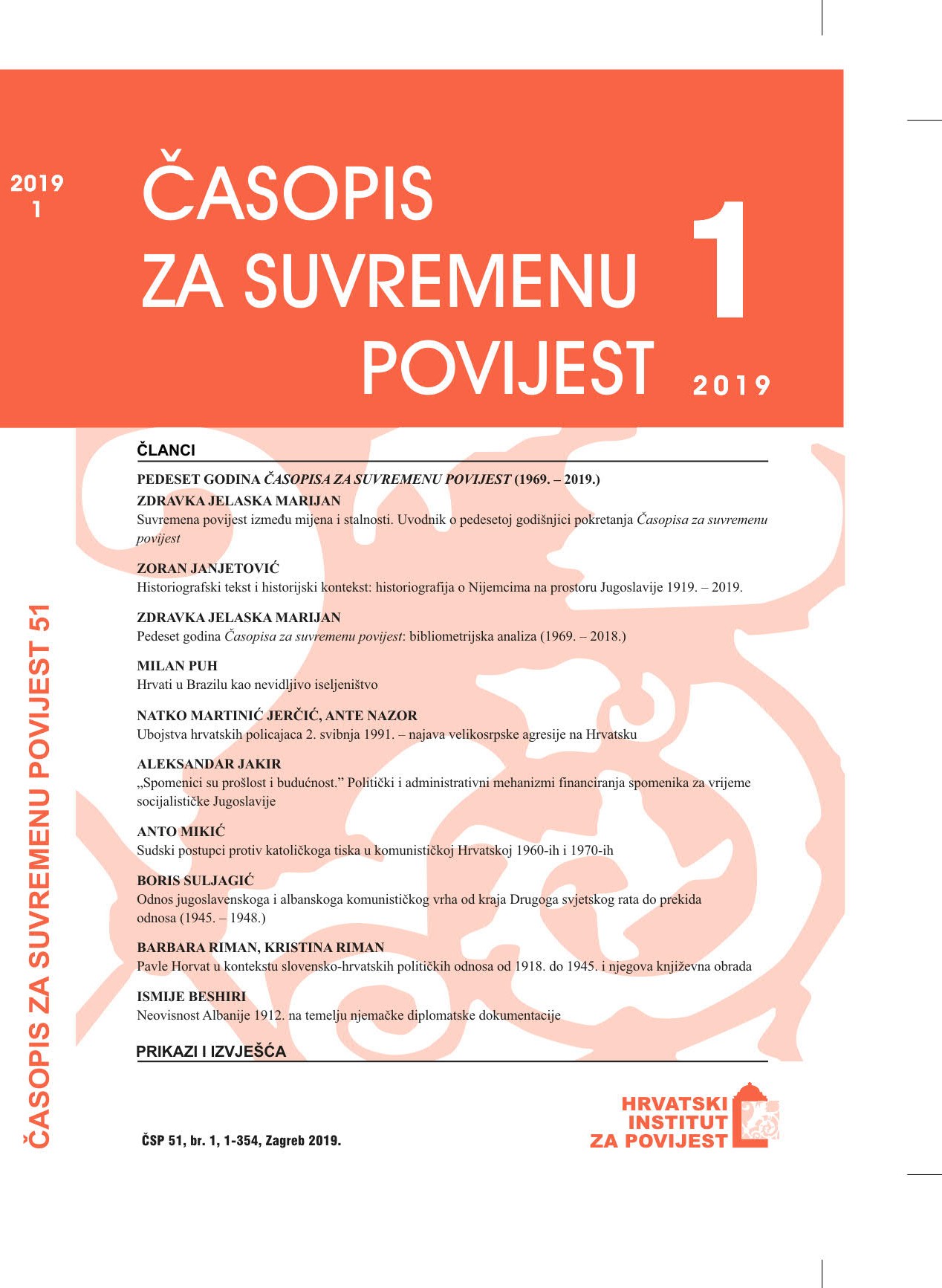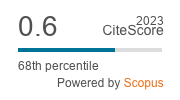Fifty Years of the Journal of Contemporary History
A Bibliometric Analysis (1969–2018)
DOI:
https://doi.org/10.22586/csp.v51i1.8471Keywords:
academic journal; bibliometric analysis; history; Croatia; Journal of Contemporary HistoryAbstract
The Journal of Contemporary History (Časopis za suvremenu povijest) has been published regularly every year during the half-century of its existence. A total of 134 volumes have been published in this period. The average length of the Journal was 700.64 pages per year. Deviations in the length of the Journal point to the existence of various favourable and unfavourable influences it has been exposed to during its history. Most of the yearly totals (23) were close to the average length, from 600 to 800 pages. The period with the obviously greatest length were the 2000s, when it greatly surpassed the average at between 900 and 1330 pages. This was likely due to the stable financial situation and employment of younger scholars through the model of junior researchers, which favourably influenced the number of scholars in the entire academic community, including the Journal’s field. The increased interest of the community for contemporary history topics after the war and political transition was probably also a factor in this.
All editors were permanent employees of the Croatian Institute of History (previously the Institute of the History of the Workers’ Movement of Croatia / the Institute of Contemporary History), the publisher of the Journal. During most of the five decades of its existence, efforts were made to include scholars from other academic institutions alongside prominent scholars employed at the Institute.
The analysis of the data on the length, number, and authorship of academic papers encompassed 1043 works published in the 1969–2018 period that had the qualities of academic papers, regardless of the classification used in the Journal at a given time. The average length of a paper fluctuated from 15 to 30 pages during the entire five-decade period of the Journal’s publishing, with the exception of the first year, when it surpassed the usual maximum. Still, it is noticeable that the average length of the papers was usually shorter during the 1970s than later. This fluctuation can be partly explained by special issues, i.e. the attempts of the editorial boards to shed light on certain topics by gathering as large a number of scholars as possible, but in doing so usually prescribing a shorter length for these thematic blocks than is usual for the Journal. This was a significant influencing factor even though there were also fluctuations in some years when there were no thematic blocks. The broadness of the topics of individual works also had a certain impact, so that the length of academic papers varied within a single volume as well. Data on the average length of papers does not show significant overlap with the data on the length of the Journal in individual years or the data on the number of academic papers published in individual years, but the total annual lengths of the Journal show a correlation with the number of academic papers.
The number of academic papers written for the Journal of Contemporary History during the first three decades of its existence shows little variation, but has increased significantly during the last two decades. Regarding the fourth decade, this can be partially linked to the increasing number of papers, but the same cannot be said of the fifth decade, when the number of academic papers dwindled while the number of authors grew, even in comparison to the fourth decade. The number of authors who published one paper in the Journal in a decade had always been large compared to the number of authors who published a large number of papers, but it continued to grow, which is indicative of the very broad circle of the Journal’s contributors. The number of authors with more than five academic papers in the last 10-year period has dwindled to zero. The circle of authors of academic papers who have contributed to the Journal during half a century was very broad and grew continuously, though the employees of the Institute, as the leading academic institution for researching contemporary Croatian history – the Journal’s focus – have always formed a solid core. The number of contributors from other institutions in Croatia continues to grow and testifies to the firm integration of the Journal into the Croatian academic community. The Journal has been directly or indirectly open towards all topics relevant to contemporary Croatian history and has published a significant number of works of authors from foreign countries, especially Croatia’s neighbours.
Downloads
Published
How to Cite
Issue
Section
License
Copyright (c) 2019 authors and journal

This work is licensed under a Creative Commons Attribution-NonCommercial 4.0 International License.
Copyright holders are the publisher Croatian Institute of History and the authors. Journal of Contemporary History is an Open Access journal. Users are allowed to read, download, copy, redistribute, print, search and link to material, and alter, transform, or build upon the material, or use them for any other lawful purpose as long as they attribute the source in an appropriate manner according to the Creative Commons licence CC BY-NC. The papers published in Journal of Contemporary History can be deposited and self-archived in the institutional and thematic repositories providing the link to the journal's web pages and HRČAK. Journal does not charge article processing charges (APC). The editors assume no responsibility for statements of fact or opinion made by contributors.




